Picking the perfect brake pads for your ride has an influence on how safe you are, how well your whip handles, and what you’ll shell out over time. You’ve got a whole menu, from wallet-easy organic pads to fancy ceramic or semi-metallic types. To get why budget brake pads ain't the same as the pricier […]

Different Types of 4-Wheelers: An Informative Guide
What are the different types of 4-wheelers? Which one is right for me?
When it comes to off-road adventure and versatile transportation, 4-wheelers stand out. They are popular choices for enthusiasts and utility users alike.
According to a report, over 1.2 million Americans own an ATV, and this number still keeps growing.
There are various four-wheelers in the market, which include ATVs (All-Terrain Vehicles) and quad bikes. These vehicles offer a range of options tailored for different uses and terrains.
Knowing the 4 wheelers types will help you choose the right vehicle for your next adventure.
Facing with different four-wheelers models, brands with different functions, how will you choose?
This guide will delve into the various types of 4-wheelers, their unique features, and the latest trends in the market.
Table of Contents
Different Types of 4-Wheelers
1. All-Terrain Vehicles (ATVs)
1.1 Utility ATVs
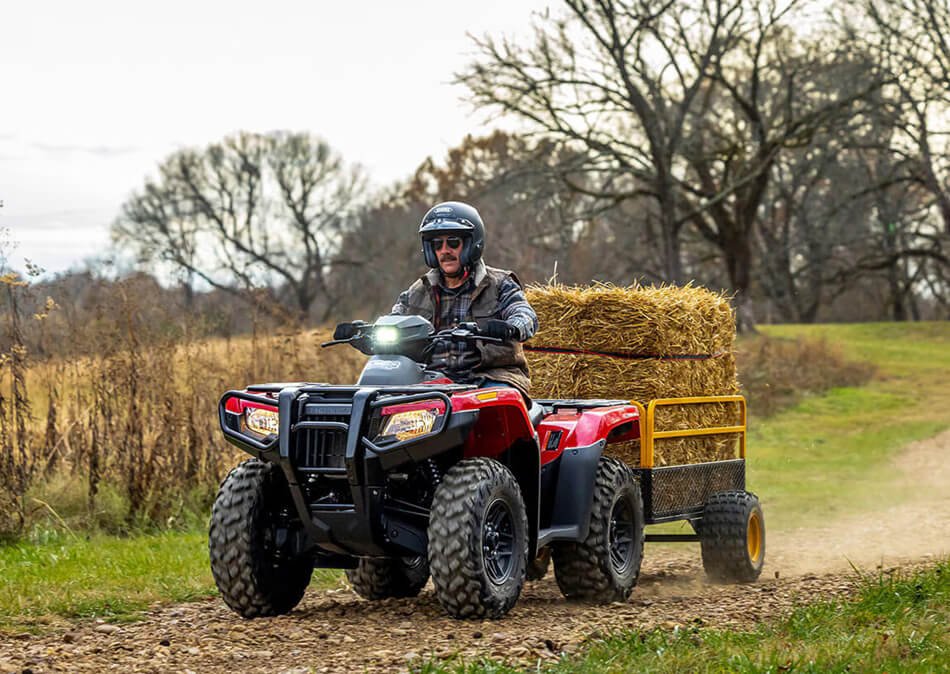
Utility ATV by Honda - Different Types of 4-Wheelers (Source: Honda)
Best Utility ATV Options:
- Bighorn Explorer 550 4x4 EFI UTV at about $11,000
- BMS Motorsports Stallion 600 RX-EFI UTV at about $10,000
- Bighorn Homestead 200 2-Speed Gas Golf Cart/UTV at about $7,300
- Bighorn Explorer 400 4x4 EFI Side by Side UTV at about $8,500
- Honda FourTrax Foreman at about $10,600
Utility ATVs are designed for practical use. This kind of four-wheelers are often employed in agricultural, construction, and recreational settings.
Most of them are equipped with powerful engines and robust frames. Thus making them suitable for towing, hauling, and navigating tough terrains.
- Features: Larger storage racks, towing capability, and durable construction.
- Use Cases: Farming tasks, hunting, and worksite transportation.
Pros and Cons:
Pros:
- √ Versatility: Can handle a variety of tasks. From farming to recreational use, making them highly versatile.
- √ Durability: Built with robust frames and strong materials. They can withstand tough terrains and heavy loads.
- √ Towing Capacity: Equipped with powerful engines. They can tow trailers and other equipment with ease.
- √ Cargo Space: Often come with racks and storage options, allowing for transport of tools and materials.
- √ All-Weather Use: Designed to perform well in various weather conditions, including mud, snow, and rain.
Cons:
- × Maneuverability: Generally larger and heavier, make them less agile compared to sport ATVs.
- × Speed: Focused more on power and torque, they are not as fast as sport models.
- × Fuel Efficiency: May consume more fuel, leading to higher running costs.
- × Initial Cost: Typically more expensive due to their size and capabilities.
- × Maintenance: The complexity and heavy-duty use can lead to higher maintenance needs.
1.2 Sport ATVs
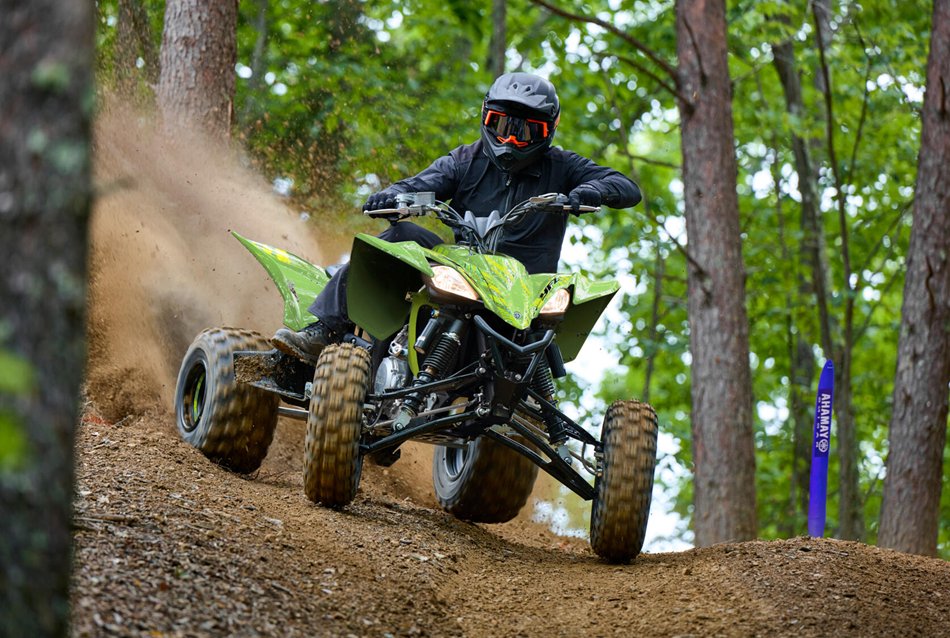
A sports ATV by Yamaha running in the forest trail (Source: Yamaha)
Top Choice Sports ATVS:
- CAN-AM RENEGADE at about $11,000
- CAN-AM RENEGADE X XC 1000R at about $15,900
- HONDA TRX250X at about $5,400
- KAWASAKI KFX90 at about $3,300
Sport ATVs are built for speed, agility, and performance. Four-wheelers of this kind are lighter and have more responsive handling, making them perfect for racing and recreational riding.
- Features: High-performance suspension, powerful acceleration, and lightweight design.
- Use Cases: Racing, trail riding, and competitive sports.
Pros and Cons:
Pros:
- √ Performance: Designed for speed and agility, offering high performance on trails and tracks.
- √ Lightweight: Typically lighter than utility models, enhancing maneuverability.
- √ Suspension: Advanced suspension systems provide a smoother ride on rough terrain.
- √ Exciting Ride: Ideal for thrill-seekers looking for adrenaline-pumping experiences.
- √ Customization: Wide range of aftermarket parts available for performance enhancements.
Cons:
- × Limited Utility: Not designed for heavy-duty tasks such as towing or hauling.
- × Less Stability: The focus on speed can make them less stable. (Especially for inexperienced riders.)
- × Comfort: Prioritizes performance over comfort. This can lead to a rougher ride on longer trips.
- × Terrain Restrictions: Best suited for specific terrains like trails and tracks. (Not ideal for all conditions.)
- × Higher Risk: The emphasis on speed and performance can increase the risk of accidents.
1.3 Youth ATVs
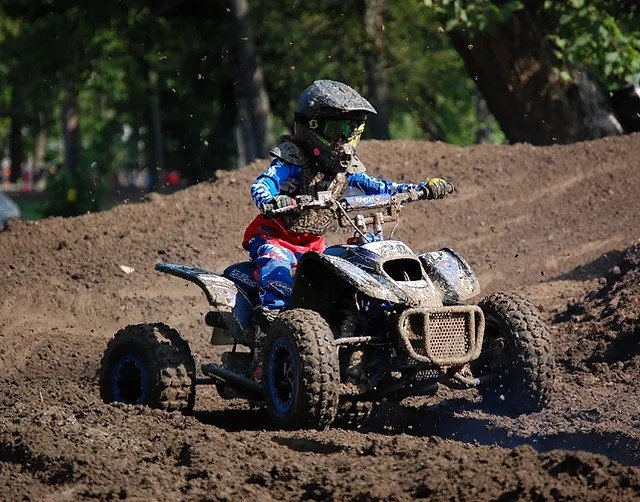
A young boy riding a DRR youth ATV in the mud trail (Source: DRR)
Youth ATVs Options:
- 2023 CAN-AM RENEGADE 70 EFI at about $2,999
- 2023 HISUN STRIKE 250R at about $5,599
- 2023 HONDA TRX90X at about $3,249
- 2023 KAWASAKI KFX50 at about $2,299
- 2023 POLARIS OUTLAW 110 EFI at about $3,599
Youth ATVS are designed specifically for younger riders. So they are smaller, lighter, and have less powerful engines. Safety features such as speed limiters and remote shut-off systems are often included.
- Features: Adjustable speed settings, smaller size, and enhanced safety features.
- Use Cases: Introducing children to off-road riding in a controlled manner.
Pros:
- √ Safety Features: Equipped with speed limiters and remote shut-off systems to ensure safety.
- √ Size and Weight: Smaller and lighter, making them easier for kids to handle.
- √ Training: Great for teaching children how to ride and manage ATVs responsibly.
- √ Fun and Adventure: Provides a sense of adventure and enjoyment tailored for younger riders.
- √ Parental Control: Allows parents to monitor and control riding conditions and limits.
Cons:
- × Limited Power: Less powerful engines, which might not satisfy older or more experienced kids.
- × Growth Limitations: Children can quickly outgrow these models, necessitating upgrades.
- × Terrain Restrictions: Not suitable for rough or challenging terrains.
- × Durability: May not withstand rough handling or frequent use as well as adult models.
- × Initial Cost: Can be expensive, especially considering the potential need for frequent upgrades.
Some riders may confused about the difference between a 4 wheeler and ATV. We have a blog Four wheeler vs Quad vs ATV – What Is The Main Difference may help you understand them more clear.
Equip with ATV Intercom for safer communication
2. Side-by-Side (SxS) Vehicles
Side-by-Side vehicles are also known as UTVs (Utility Task Vehicles). Four wheelers in this category are larger than traditional ATVs and can seat 2 or more people side by side. They are versatile and come in various designs tailored for specific tasks.
2.1 Utility SxS

A Kawasaki utility SxS riding on the farm
Utility SxS Best Options:
- Polaris Ranger at about $17,990
- John Deere Gator at about $13,499
- Honda FourTrax Foreman Rubicon at about $7,599
- Kawasaki Mule at about $12,599
- Honda FourTrax Rancher 4×4 at about $7,249
These are akin to utility ATVs but offer more seating and storage. They are highly favored for work-related tasks due to their capacity and durability.
- Features: Multiple seating options, large cargo beds, and enhanced towing capabilities.
- Use Cases: Agriculture, construction, and transporting tools or equipment.
Pros:
- √ Seating Capacity: Offers multiple seats, making it ideal for transporting passengers and gear.
- √ Cargo Space: Large cargo beds provide ample storage for equipment and supplies.
- √ Towing Capability: High towing capacity for hauling trailers and heavy loads.
- √ Versatility: Suitable for a wide range of tasks, from farming to recreational use.
- √ Stability: Wider stance offers better stability on uneven terrain.
Cons:
- × Size: Larger size can limit access to narrow trails and tight spaces.
- × Cost: Generally more expensive than single-rider ATVs.
- × Fuel Efficiency: Larger engines may consume more fuel, leading to higher operating costs.
- × Maintenance: More complex systems can require frequent maintenance and repairs.
- × Maneuverability: Less agile compared to smaller ATVs, especially in tight or technical areas.
2.2 Sport SxS
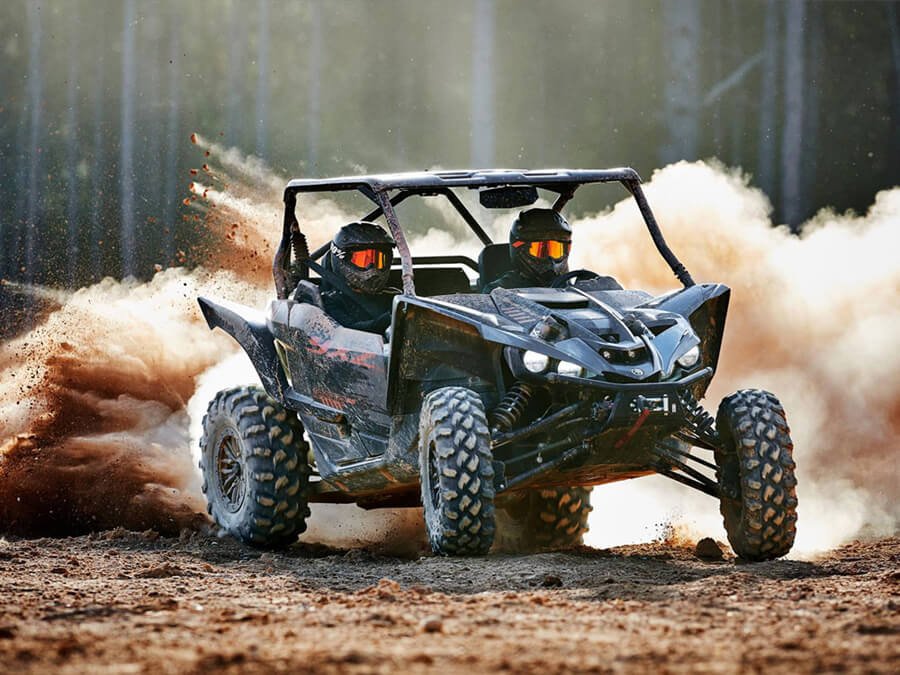
Sport SxS - Different 4-Wheelers types
Sport SxS 4-wheelers options:
- Kawasaki Teryx KRX 1000 eS at about $23,399
- Kawasaki Ridge XR HVAC at about $31,999
- Polaris RZR XP 1000 Sport at about $20,999
- Polaris RZR Pro R Ultimate at about $40,999
Sport SxS vehicles focus on speed and maneuverability. They are popular in off-road racing and recreational activities.
- Features: High horsepower, advanced suspension systems, and sporty design.
- Use Cases: Off-road rallies, dune bashing, and adrenaline-fueled adventures.
Pros:
- √ High Performance: Designed for speed and agility, perfect for racing and off-road adventures.
- √ Advanced Suspension: Equipped with superior suspension systems for handling rough terrain smoothly.
- √ Thrill Factor: Provides an exciting and adrenaline-pumping experience.
- √ Customization Options: Wide range of aftermarket parts for tuning and performance enhancements.
- √ Passenger Experience: Allows multiple passengers to enjoy the ride together.
Cons:
- × Cost: Generally more expensive due to advanced features and performance capabilities.
- × Fuel Consumption: Powerful engines can lead to higher fuel costs.
- × Limited Utility: Not designed for tasks like towing or heavy hauling.
- × Size: Larger size can restrict access to narrow trails.
- × Maintenance: Requires regular upkeep to maintain performance and safety features.
2.3 Recreational SxS
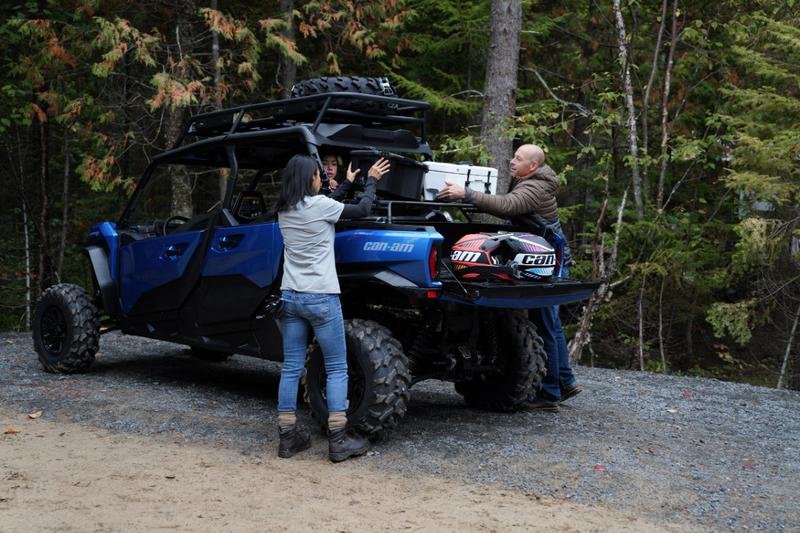
A family riding a recreational sxs for outdoor activity
Recreational SxS best option:
- 2023 Yamaha Wolverine RMAX 2 1000 at about $23,999
- 2023 Can-Am Commander XT 700 at about $17,000
These models strike a balance between utility SxS and sport SxS. Thus this kind of 4 wheelers offers comfort and flexibility for families and groups.
- Features: Comfortable seating, moderate cargo space, and adaptable performance.
- Use Cases: Family outings, camping trips, and leisurely trail exploration.
Pros:
- √ Comfortable Ride: Designed for a smooth and enjoyable ride with comfortable seating.
- √ Versatility: Suitable for both leisure activities and light utility tasks.
- √ Passenger Capacity: Can accommodate multiple passengers, making it great for family outings.
- √ Balanced Performance: Offers a good mix of speed and handling for various terrains.
- √ User-Friendly: Easy to drive, making it accessible for riders of different experience levels.
Cons:
- × Moderate Power: Not as powerful as sport-specific models, which may limit extreme performance.
- × Size: Larger size can be cumbersome on narrow trails.
- × More Cost: Can be expensive, especially with additional features and options.
- × Fuel Efficiency: May consume more fuel than smaller or single-rider alternatives.
- × Limited Cargo: Less cargo space compared to utility-focused models.
3. Amphibious 4-Wheelers
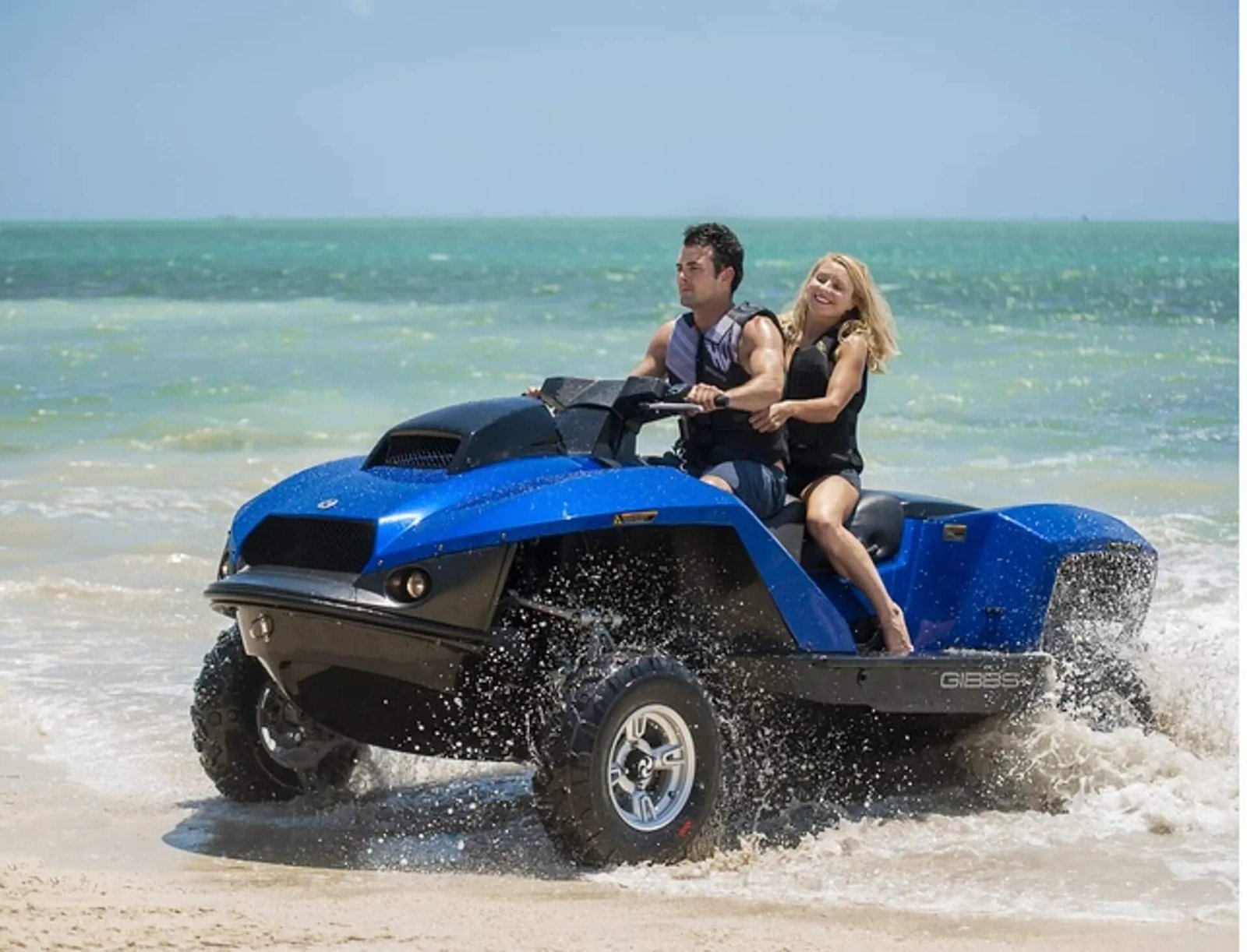
An amphibious 4-wheelers riding at the sea beach
Amphibious 4-Wheelers Best Options:
- Shaman 8 x 8 (~$250,000)
- Predator 4x4 (€59,600-€66,000)
- Trecol Husky ($69,000)
- Storm MPV ($125,805)
- Sherp ATV ( $115,000-$126,000)
Amphibious 4-wheelers are unique vehicles capable of traversing both land and water. They are ideal for environments where crossing water bodies is necessary.
- Features: Sealed bodies, buoyant tires, and dual-mode operation.
- Use Cases: Wetland exploration, fishing trips, and rescue operations.
Pros:
- √ Dual Terrain Capability: Can traverse both land and water, offering unique versatility.
- √ Adventure Opportunities: Ideal for exploring wetlands, rivers, and other aquatic environments.
- √ Innovative Design: Features like buoyant tires and sealed bodies enhance functionality.
- √ Utility Use: Useful for tasks in areas with mixed terrains, such as rescue operations.
- √ Unique Experience: Provides a distinctive and exciting riding experience.
Cons:
- × Complexity: More complex systems can lead to higher maintenance needs.
- × Cost: Typically more expensive due to specialized design and features.
- × Speed Limitations: Often slower on land compared to traditional ATVs.
- × Weight: Heavier than standard models, which can affect maneuverability.
- × Terrain Restrictions: Not suitable for all environments, particularly very rocky or steep areas.
4. Electric 4-Wheelers
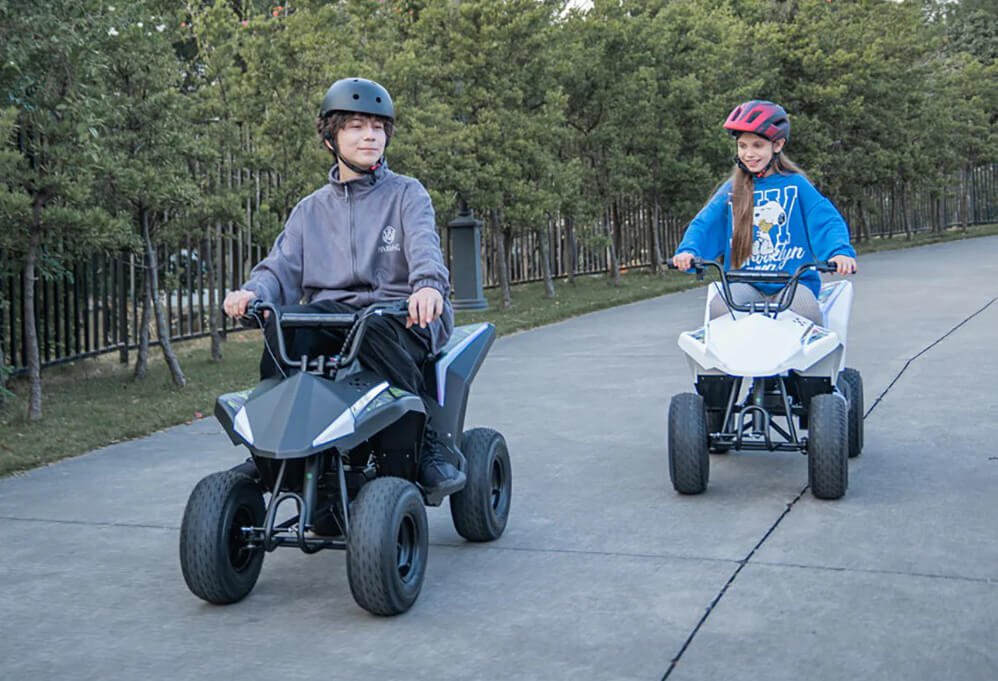
electric 4-wheelers riding
Best Electric 4-Wheelers options:
- Eco Charger Lithium Prestige at about $27,400
- Eco Charger Eliminator 4WD at about $20,500
- DRR EV Safari 4×4 at about $15,000
- Eco-Rider Explorer G.T. at about $6,700
- Tesla CyberQuad at about $1,900
With the surge in electric vehicle technology, electric 4-wheelers are becoming increasingly popular. This kind of 4-wheelers offer eco-friendly alternatives with reduced noise and emissions.
- Features: Electric motors, rechargeable batteries, and quiet operation.
- Use Cases: Urban use, eco-conscious recreational riding, and areas with strict noise regulations.
Pros:
- √ Eco-Friendly: Zero emissions reduce environmental impact.
- √ Low Maintenance: Fewer moving parts mean lower maintenance costs.
- √ Instant Torque: Quick acceleration for a smooth driving experience.
- √ Quiet Operation: Reduced noise pollution.
- √ Energy Efficiency: Higher efficiency compared to internal combustion engines.
Cons:
- × High Initial Cost: More expensive upfront than traditional motors.
- × Limited Range: Shorter distance per charge compared to gasoline engines.
- × Charging Time: Longer to charge than refueling a gas tank.
- × Infrastructure: Limited charging stations in some areas.
- × Battery Degradation: Performance may decrease over time.
Now, we have introduced you the most commonly seen types of 4-wheelers on the market. Each of them has their own features and use cases. So, you will need to consider according to their application and your specific demand.
Choosing the Right 4-Wheeler
When selecting a 4-wheeler, consider the following factors:
- Purpose: Determine the primary use, whether for work, sport, or leisure.
- Terrain: Assess the types of terrain you will mostly encounter, such as trails, mud, or dunes.
- Budget: Establish a budget that includes potential maintenance and upgrades.
- Experience Level: Choose a model that matches your skill level, especially if you are a beginner.
Different 4-Wheelers: Safety First
Safety is always the first while we are riding with different kinds of 4 wheelers.
Choose the right clothing for the weather, riding conditions, and your vehicle.
For example, if you're riding an ATV or unenclosed UTV, clothing that's breathable and moisture-wicking will be the best choice. You can choose long-sleeved shirts and pants, and they will protect your skin from external damage (such as sun, stones, debris, etc.).
Gloves and ATV boots are also indispensable equipment. Remember to wear a full-face or half-face four-wheelers helmet. A helmet with goggles can increase visibility and protect the head.
In addition, installing a Bluetooth communication system on the helmet will help you communicate with your companions smoothly and quickly. For example, Fodsports FX7 supports Bluetooth mesh communication, and the riders in the group are connected to each other, which can achieve very efficient communication. When any rider joins or leaves the group, the communication of others will not be affected.
Talk With Other 4-Wheelers By ATV Intercoms
What's more, it is important to familiarize yourself with the controls and capabilities of your 4-wheeler. If it is the first time you ride a new kind of 4-wheeler, be sure you have understand it before you start it up.
Remember to abide by local laws and guidelines for off-road vehicles. This is important to make sure the safety of you and other participants on the road.
Besides, avoid risky maneuvers and respect the environment and other riders.
For detailed ATV safety tips, read our blog: ATV Safety Tips: Your Ultimate Guide to Safe Riding
Conclusion
4-wheelers offer an exciting and versatile way to explore the outdoors, complete work tasks, and enjoy recreational activities.
There are various different types of 4-wheelers suited for different purposes in the market. So, understanding the options available can help you make an informed decision.
Whether you’re seeking adventure, utility, or eco-friendly alternatives, there’s a 4-wheeler out there to meet your needs.
Always prioritize safety and responsible riding to make the most of your 4-wheeling experience.

With over 10 years of experience working on cars and trucks Item Training Supervisor Richard Reina is known around the office as one of our technical experts & real an "automobile person".
His rate of interest began, in his very own words, "at the age of two when his father educated him the distinction in between a Chevy and a Ford. Since then it's been cars regularly."
As a serious lover of practically all things with a motor Richard can address nearly any kind of inquiry related to car upkeep, fixing, or restoration & is a fact professional in electric motor background.
E-bikes have transformed into more than just gadgets to help you get around. Now, they're speed demons that can go toe-to-toe with motorbikes. It’s 2025, and these speedy machines have gotten a huge boost from better motors, more powerful batteries, and sleek designs that cut through the air like a knife. Let’s dive into the […]
Many riders who aren't so tall or ladies just starting to ride bikes need to pick out the best Motorcycles for Short Riders and Women. They gotta look for three key things: a seat that's not too high up, a bike that's not too heavy, and something that looks good enough to give them confidence. […]
As we accelerate into 2025, motorbikes are getting a serious tech upgrade. They’re all about safer rides and more fun on the road. Even if you’re a pro or just starting, kitting out your two-wheeler with cool tech stuff is a game-changer. Check out these ten top motorcycle gadgets each motorcyclist will want in 2025. […]
Getting around the city every day can be super annoying. You've got traffic like molasses nowhere to park, fuel prices through the roof, and buses stuffed like sardine cans make heading to the office a real pain. For loads of folks, getting a motorcycle is a pretty slick move—they’re nimble, cost-effective, and perfect for squeezing […]
Rider safety demands motorcycle helmets. Yet, riders still clash over picking full-face vs open-face helmets. Full-face ones take the win for protecting in crashes, but open-face models charm folks who want cool looks better air, and that old-school vibe. This guide dives into the latest research, technological advancements, and real-world insights to help you decide […]


This is a good start to an informative piece about 4-wheeler safety. Here are some suggestions to make it even better:
Enhancements and Additions:
Expand on Clothing Choices: While you mention breathable and moisture-wicking clothing, you could add more detail. For example:
Layering: Explain the importance of layering, especially in varying weather conditions. This allows riders to adjust to changing temperatures.
Specific Materials: Mention materials like moisture-wicking synthetics, abrasion-resistant fabrics (like Cordura), and waterproof/windproof outer layers.
Color: Recommend bright colors for increased visibility.
Helmet Details: Go beyond just mentioning helmets.
DOT Approval: Emphasize the importance of helmets that meet DOT (Department of Transportation) standards.
Proper Fit: Explain how to ensure a helmet fits correctly.
Face Shield/Goggles: Highlight the importance of eye protection, even with a full-face helmet. Mention UV protection.
Gloves and Boots: Similar to helmets, provide more detail:
Gloves: Should offer good grip and protect against abrasions.
Boots: Should be designed for off-road riding, offering ankle support and protection.
Pre-Ride Inspection: This is crucial. Add a section on the importance of inspecting the 4-wheeler before each ride. Include key checks:
Tire pressure and condition
Brakes
Lights
Fluid levels (oil, coolant, etc.)
Throttle and steering
Rider Training: Highly recommend formal rider training courses. These courses teach essential skills and safety practices.
Weight Limits and Passengers: Clearly state the importance of adhering to the 4-wheeler's weight limits and passenger restrictions. Never overload the vehicle. Also, emphasize that some 4-wheelers are designed for single riders only.
Terrain Awareness: Discuss the importance of being aware of the terrain and riding conditions. Avoid riding in areas that are too challenging for your skill level or the vehicle.
Alcohol and Drugs: Absolutely essential: Never operate a 4-wheeler under the influence of alcohol or drugs.
Environmental Considerations: Expand on respecting the environment. Stay on designated trails, avoid disturbing wildlife, and pack out all trash.
Group Riding: If riding in a group, emphasize the importance of pre-ride briefings, communication (as you mentioned with Bluetooth systems), and staying within sight of each other.
Emergency Preparedness: Recommend carrying a first-aid kit, a map, a compass or GPS, and a communication device (like a satellite phone in remote areas). Know basic first aid.
Specific Examples of Risky Maneuvers: Instead of just saying "avoid risky maneuvers," give examples: wheelies, jumps, excessive speed, riding on two wheels.
Age Restrictions: Mention age restrictions for operating different types of 4-wheelers.
Structure and Flow:
Introduction: Could be more engaging. Perhaps start with a brief anecdote or a question about the appeal of 4-wheeling.
Headings and Subheadings: Use clear headings and subheadings to break up the text and make it easier to read. For example: "Gear Up for Safety," "Pre-Ride Checks," "Riding Responsibly," "Respecting the Environment."
Call to Action: End with a stronger call to action. Encourage readers to take a rider safety course, inspect their 4-wheeler before each ride, and always prioritize safety.
Example of a revised section:
Gear Up for Safety:
"Choosing the right gear is paramount for a safe and enjoyable 4-wheeling experience. Your clothing should protect you from the elements, as well as potential injuries. Consider these essentials:
Layering: Layering is key to staying comfortable in changing weather. Start with a moisture-wicking base layer, add an insulating mid-layer (like fleece), and top it off with a waterproof and windproof outer shell.
Materials: Look for moisture-wicking synthetic fabrics for your base layer. Durable, abrasion-resistant materials like Cordura are ideal for pants and jackets. Bright colors enhance visibility.
Helmets: A DOT-approved helmet is non-negotiable. Ensure a proper fit – it should be snug but not too tight. A full-face helmet offers the best protection, but a half-face helmet with goggles is also acceptable. Always wear eye protection, even with a full-face helmet, to shield your eyes from dust, debris, and UV rays.
Gloves: Gloves provide crucial grip and protect your hands from abrasions. Choose gloves designed for off-road riding.
Boots: Sturdy, over-the-ankle boots designed for off-road use offer essential ankle support and protection."
By incorporating these suggestions, you can create a more comprehensive and effective guide to 4-wheeler safety.